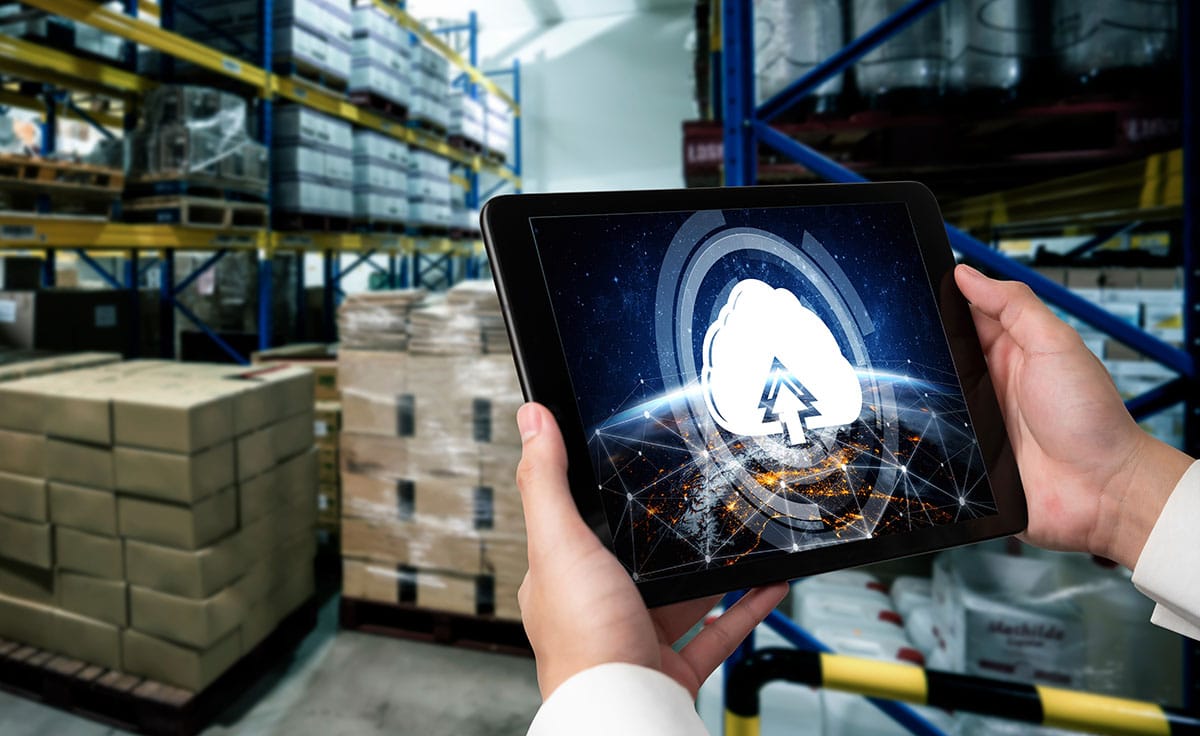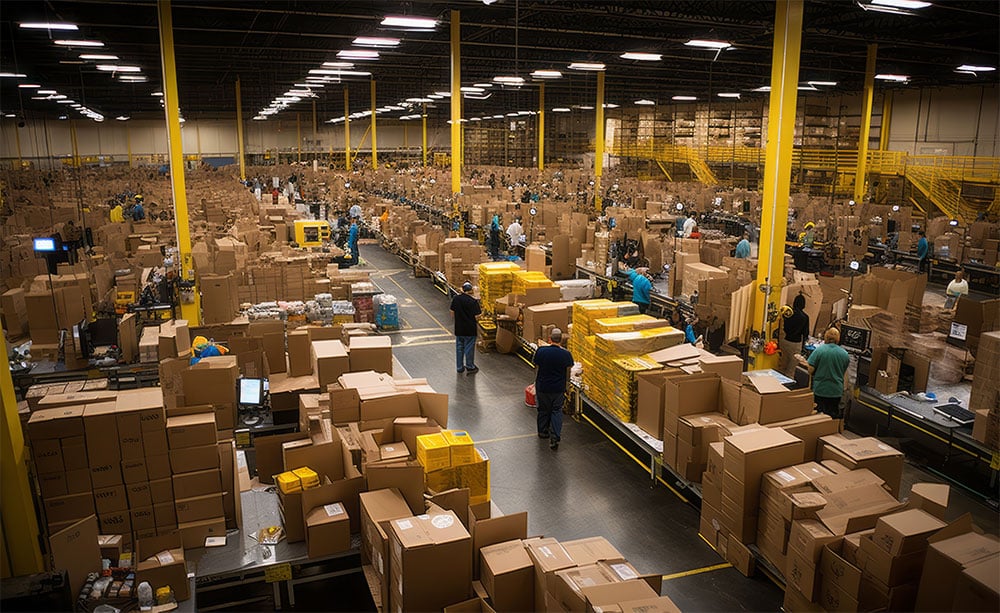By Patrick Byers, DevOps Engineer, Lucas Systems
 The warehousing and distribution industry is highly reliant on technology for its operations. As such, it is vulnerable to devastating cyberattacks. Cybercriminals are increasingly targeting this growing sector due to the large amounts of data stored in these systems and their potential value. In fact, #1 among Gartner’s 8 cybersecurity predictions for 2023 is that supply chain and geopolitical risk will dominate cybersecurity. This article will explore some of the key impacts of cyberattacks in the warehouse and distribution industry, as well as strategies businesses can employ to protect themselves from these threats.
The warehousing and distribution industry is highly reliant on technology for its operations. As such, it is vulnerable to devastating cyberattacks. Cybercriminals are increasingly targeting this growing sector due to the large amounts of data stored in these systems and their potential value. In fact, #1 among Gartner’s 8 cybersecurity predictions for 2023 is that supply chain and geopolitical risk will dominate cybersecurity. This article will explore some of the key impacts of cyberattacks in the warehouse and distribution industry, as well as strategies businesses can employ to protect themselves from these threats.
Why are warehouses and DCs so vulnerable to cyberattacks?
In today’s interconnected world, the distribution industry has become increasingly complex and reliant on technology to manage inventory, track shipments, and communicate with suppliers and customers. This dependence on technology also makes the industry vulnerable to cyberattacks, which can disrupt operations, compromise sensitive data, and cause financial losses.
One of the primary reasons for this high-level of vulnerability to cyberattacks is the sheer number of interconnected systems and third-party vendors involved in the entire distribution process. Warehouse and DC operations can involve hundreds of suppliers, manufacturers, and logistics providers, each with their own network and security protocols. Any weak link in this chain can be exploited by cybercriminals, who can use malware, phishing scams, or other tactics to gain access to sensitive data or disrupt operations.
The rise of the Internet of Things (IoT) and other connected devices has created new opportunities for cyberattacks. These devices can sometimes be poorly secured, making them easy targets for hackers who can use them to gain access to other systems or launch attacks. For example, the rise of RaaS (Robots as a Service) within the warehouse means that 3rd party devices (robots) are integrated into your environment and actively streaming your data while actually owned and maintained by an outside party.
Additionally, the global nature of supply chains means that companies are increasingly exposed to cyber threats from overseas. Many suppliers and manufacturers have operations in countries with weaker cybersecurity laws and regulations, making it easier for cybercriminals to exploit vulnerabilities and steal data from links across the supply chain, including warehouses and DCs.
What are the true costs of a cyberattack?
The financial cost associated with recovering from an attack can be immense, climbing into the millions of dollars including costs related to restoring systems or replacing lost technical infrastructure or data. Companies may also suffer losses due to downtime caused by an attack, resulting in disruption to operations and delays in shipments. These side effects of an attack could lead to customer dissatisfaction and reduced profits. Furthermore, companies may incur fines or legal fees if they fail to comply with regulations related to data protection following a breach.
A 2020 cyberattack at TFI International, one of the largest trucking and logistics companies in North America, forced them to resort to manually sorting. It ended up costing TFI about $6 million in quarterly operating revenue.
In another case, CMA CGM, one of the global leaders in cargo shipping, ultimately disabled its entire core IT systems in response to a cyberattack. Most of the disruption happened within e-commerce operations. Some functions were down for two weeks, but the impacts reflected the global scope of the company. CMA CGM disclosed that the cost of the attack was up to $50 million.
If customers become aware that their data has been compromised through a security breach, they may choose to take their business elsewhere out of fear that their information could be at risk again in future transactions. This loss of trust in your company’s ability to provide secure services and effectively manage confidential information could clearly result in real costs via loss of customers or additional friction when gaining new ones.
Keep in mind as well the cost (or loss) of cyber-security insurance if you have a breach or do not have a solid security posture. Many customers will not do business with you if you do not have cybersecurity insurance or do not have a certain level of coverage.
How can you best be prepared against a cyberattack in your DC operations?
It’s critical to invest resources into developing incident response plans that prepare your warehouse and DC team to respond swiftly and appropriately should something happen. Some of the basic points any plan should include are the use of encryption in accordance with security standards, controlling access points, proper training on computer security systems, and lastly raising awareness among employees.
Implementing robust IT security measures across all systems in your warehouse ensure sensitive data, such as customer information, financial records, and inventory management data, remains protected. These include installing anti-virus software, firewalls, multi-factor authentication, and encrypting communications between machines, to name a few.
The critical elements of cybersecurity in your warehouse
Anti-virus software is designed to detect and remove malware, viruses, and other malicious software that can compromise the network’s security. Make sure it has real-time scanning capabilities, automatic updates, and regular system scans to ensure continuous protection. Make sure to customize settings for your specific environment. For example, configure the software to avoid excessive system resource consumption during peak hours or times of high activity. This will help ensure that the antivirus software does not interfere with critical operations while still providing adequate protection.
Firewalls act as a barrier between the internal network and the external internet, preventing unauthorized access to the network. This is particularly important for warehouses that rely on cloud-based inventory management systems or other web-based applications. Firewalls allow warehouse administrators to define access rules and policies for different network segments or devices. They enable granular control over network traffic by filtering based on IP addresses, ports, protocols, and other criteria. Because warehouses often handle sensitive information, including customer data, financial records, and proprietary business information, compliance with industry regulations, such as the General Data Protection Regulation (GDPR) or the Payment Card Industry Data Security Standard (PCI DSS), may be required. Technology firewalls play a crucial role in ensuring that the warehouse network meets these compliance requirements.
Multi-factor authentication (MFA) is another essential security measure that warehouse managers can implement. MFA adds an extra layer of security to the login process by requiring users to provide two or more forms of identification. This can include a password, a biometric factor such as a fingerprint or retina scan, or a one-time code sent to the user’s phone or email. This can also take the form of access control systems (ID or smart card and PIN). By implementing MFA, warehouse managers can prevent unauthorized access to their network, even if a user’s password is compromised.
Encrypting communications between machines is also crucial for ensuring data security in warehouses. This is particularly important for warehouses that rely on wireless networks to connect their devices protecting inventory management systems, shipping systems, and customer databases. Encryption is vital for securing data transmission between these systems, ensuring that sensitive information remains protected while in transit. Encryption is not only important for guarding against external threats but also helps mitigate risks posed by insider threats. Employees or contractors with access to sensitive data may attempt unauthorized data access, theft, or disclosure. Encryption adds an extra layer of security, ensuring that even if an insider gains access to encrypted data, they cannot view its contents without the appropriate decryption keys.
Implementing IT security measures is not just about protecting sensitive data; it can save warehouses from significant financial losses. A cyber-attack can cause a significant disruption to operations, leading to downtime, loss of revenue, and damage to the warehouse’s reputation. Additionally, data breaches can lead to hefty fines and legal liabilities, which can be financially devastating for a small business.
For example, in 2017, shipping giant Maersk suffered a malware attack that spread from their IT systems to their operational tech and cost the company an estimated $300 million in damages. The attack disrupted the company’s operations for several weeks, causing significant financial losses and damage to its reputation. Similarly, Target suffered a massive data breach in 2013 that cost the company $18.5 million in settlement payments and millions more in lost revenue.
Legacy software and hardware systems can often represent a significant vulnerability to cyberattack, especially if they are unsupported in terms of updates, security fixes, and general enhancements that address emerging threats. For example, many operational technology systems are older, legacy systems not designed for remote operation or to be connected to the internet. As a result, cybersecurity measures are not inherently part of system design. Having redundant data backup sites is the best way to ensure access to critical data in a breach.
Staff should be regularly trained to spot the common warning signs of suspicious activity. Employees are often considered the weakest link when it comes to cybersecurity. Many are so wrapped up in the daily tasks that they forget to pay attention to emails, pop-ups, texts, passwords, and other avenues hackers can use to break through your protections, even direct social engineering. Invest in employee education and training to reduce the risk of cyberattacks. By providing regular training sessions and resources, companies can empower their employees to recognize and respond to potential threats. This can include teaching employees about safe browsing habits, how to identify suspicious emails or links, and the importance of updating software and passwords regularly. Instilling a culture of cybersecurity awareness reduces the likelihood of employees inadvertently opening the door to cybercriminals.
Implementing robust IT security measures is essential for protecting sensitive data and preventing cyberattacks in warehouses. Installing anti-virus software, firewalls, multi-factor authentication, and encrypting communications between machines are just a few of the security measures that warehouse managers can implement to ensure their systems are protected against cyber threats. By prioritizing data security, warehouses can avoid significant financial losses, maintain customer trust, and protect their business from the consequences of cybercrime.
 Patrick Byers leads internal automation and engineering processes at Lucas Systems, developing software-centered solutions that solve business problems for Lucas warehouse and DC customers throughout the world.
Patrick Byers leads internal automation and engineering processes at Lucas Systems, developing software-centered solutions that solve business problems for Lucas warehouse and DC customers throughout the world.
With a keen focus on improving end user quality of life and maximizing the warehouse floor workers’ experience, Patrick strives for continuous improvement in the processes and technology he oversees. Patrick is uniquely skilled in software development, automation, visualization, data organization, user experience and interface design.
He earned a Bachelor of Science degree in Information Sciences and Technology: Design and Development with a Minor in Security and Risk Analysis from Penn State University. He has also completed post graduate studies in software testing, programming practices, and development operations.





